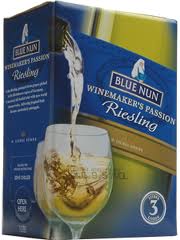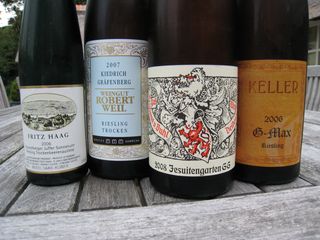In 1909, Berry Bros & Rudd in London charged 200 shillings for a case of 1893 Schloss Johannisberg Cabinet. In those days, BBR would sell you a case of the undoubtedly magnificent Château Lafite-Rothschild 1899 for 72 shillings. That was a century ago - but only very recently we mostly associated German wine with inexcusable plonk like Blue Nun and Black Tower. Non-wines dusted with liberal quantities of sugar to hide their defects. What went wrong for German wine during the 20th century?

To cut a long story short: the 1971 wine law was the root cause of all evil. From 1971 on, in Germany legally speaking the sweetest grapes by definition made the best wine. Sugar content was all that mattered. Not the grape variety, not the quality of the vineyard (terroir), not the yield. Being law-abiding citizens, German wine growers fell for the socialist ploy 'en masse' and with the help of fertilizer, herbicides and pesticides they started producing immense quantities of dull, insipid sweet wine from inferior grape varieties - think grape juice mixed with alcohol.
Some top producers (like JJ Prüm and Egon Müller) stuck to their guns, but many went through a rough patch and some historic estates succumbed altogether (like Schloss Eltz and Schloss Groenesteyn in the Rheingau). The world was starting to ignore German wine - and for good reason. This unhappy situation lasted until the late eighties/early nineties, when growers started to realise that Germany was squandering its great wine heritage.
Now some twenty years later, the German move back towards quality is a resounding success. Of course, some people still "faire pisser la vigne" as they say in France, but that happens everwhere. Quality-conscious growers will voluntarily limit yields and use only the best grape varieties (Riesling mainly, with Silvaner in Franken and Pinots Blanc and Gris in Baden). (Semi-)sweet wines are very much a part of German wine culture and can be counted among the greatest wines in the world, but dry wines are very much back in fashion and nowadays they are very well made indeed. They combine lovely ripe fruit with a stylish minerality and an uplifting acidity. A tenner will buy you an excellent bottle of Kabinett Trocken that is very digestible (often 12.5% or less), lovely on its own and extremely versatile when paired with food. But the name of the grower is all-important - do enlist the help of a good wine guide or wine merchant. Mark-ups in restaurants for these wines tend to be quite reasonable - a consequence of their relative obscurity still.
The top dry whites are called Grosses Gewächs (great growth) or, in the Rheingau, Erstes Gewächs (first growth). These are the big guns, which provide lots of power, terroir in abundance and will easily last for a decade. They are not cheap (generally speaking € 20 - € 30, but how much is that when compared to Burgundy?) but they shouldn't be, as they represent the pinnacle of German dry wine.

Pinot Noir does very well in Germany too. It always has; in recent years I tasted "Spätburgunder" from the Assmannshäuser Höllenberg vineyard in the Rheingau from 1959, 1949, 1943 and 1938 - all excellent still. But global warming certainly helps and nowadays 1/3 of all wine produced in Germany is red. They even make top-notch red on the Moselle these days! Someone once asked me: "What is the point of German red, when you already have Burgundy?" The answer I gave him is: the soil. In Burgundy it's essentially limestone and marl. German terroirs are extremely varied and this provides for an almost infinite variety of wine styles. And as it happens, I think Pinot Noir grown on slate (like in the Ahr valley) is just about the most delectable red wine in the world. But so do many Germans and quantities are small, so "not cheap" is quite an understatement....
Xavier Auerbach












